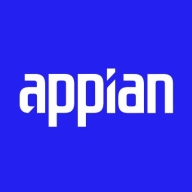

Appian and AuraQuantic are leading contenders in business process management platforms. Appian often takes the lead for its affordable pricing and support, whereas AuraQuantic excels with its powerful features justifying the higher investment.
Features: Appian offers a robust automation capability and a low-code interface, enhancing workflow efficiency. It provides seamless integration and an intuitive design that supports rapid application development. AuraQuantic stands out with its advanced integration options and visual modeling tools, catering to intricate processes. It enables customization with its zero-code approach that simplifies process automation.
Room for Improvement: Appian could enhance its customization capabilities and expand its deployment flexibility. Additionally, improving the user interface for easier navigation could boost user satisfaction. AuraQuantic may benefit from offering more competitive pricing options and streamlining its deployment process. Enhancing user documentation could also support a better user experience.
Ease of Deployment and Customer Service: Appian is well-regarded for its straightforward cloud-based deployment, complemented by strong customer support that enables rapid implementation. AuraQuantic provides flexible deployment options, including both cloud and on-premises, along with proactive customer service to ensure smooth transitions.
Pricing and ROI: Appian is typically more affordable, making it an attractive option for smaller projects with a faster break-even time. AuraQuantic, although having higher initial costs, offers substantial ROI through its extensive feature set, beneficial for large-scale enterprise operations.
Appian is very efficient, allowing us to build a lot of applications within a financial year, making it cost-effective.
Their customer service is responsive, and the team is very prompt for support.
The technical support is generally good.
Appian has a community where I can put my questions.
Appian is scalable, but it depends on how you build your applications.
Initially, without much coding, I can easily handle five thousand records.
It depends on how it has been designed and how it has been configured.
I would like to see more enhancement in the user interface to allow more freedom in designing the sites and pages.
If there is a very complex process that includes a lot of data transitioning and memory-centric processes, it consumes a lot of memory.
On the pricier side, both Appian and Pega are enterprise-level solutions, placing them on the slightly higher side.
The pricing of Appian is based on the number of users and generally ranges from 70 to 100 USD per user per month.
The zero-code integration feature is remarkable, allowing for ease of data transfer and workflow enhancement.
It is easy for me to define the process and create configurable workflows.
I can create tables, perform database-related activities, and create multiple tables.


Appian is a unified low-code platform and solution used by businesses to build enterprise applications and workflows. This product adapts to the needs of clients and the technologies they are already using to combine their data in a single workflow and maximize resources. The platform has four main components through which it transforms the work process for companies of various sizes. They are:
Appian is utilized across a diverse set of industries, including automotive and manufacturing, energy and utilities, education, financial services, telecom and media, transportation, retail, insurance, healthcare, and life sciences. The most frequent use cases of Appian are customer journey, governance, risk and compliance, operational efficiency, supply chain, distributed order management, and environmental, social, and governance (ESG) management.
Appian Features
Appian has various features that allow users to create solutions for their businesses. These features can be separated into a few groups according to function, including automation, low-code application development, and integrations and data. Some of the most frequently used features of Appian include:
Appian Benefits
The benefits of using Appian include:
Reviews from Real Users
A practice leader - digital process automation at a computer software company values Appian highly because the product is easy to develop, low-code, and has a good user interface.
Alan G., an advisory board member at Codecon VR, Appian offers a clear application life cycle, easy to learn documentation, and comes with a fundamentals course.
AuraQuantic is a digital platform designed for business users to easily and rapidly build unlimited processes and applications to automate end-to-end operations, reducing costs and optimizing productivity.
AuraQuantic is a no-code platform for building the enterprise solutions that drive Digital Transformation.
Delight users with attractive interfaces across multiple devices and deliver the best user experience. Respond immediately to their ever-changing needs with the agility provided by the platform and its no-code changes on the fly.
This is the most powerful part of any application. This is why AuraQuantic offers a long list of built-in, no-code functionalities.
To manage application and process data models, AuraQuantic provides a visual data model designer and supports importing data schemas.
Access rights management (to apps and app development), Application metadata collection, Application performance monitoring, Application works dashboard, Custom ‘guardrails’ for practitioners/developers, Role-based access control to data and services for app dev, Multiple practitioners/developers for a single app and across the platform.
Digital Decisioning features aim to inform and automate operational decisions. These decisions continue to increase in amount and complexity due to growing customer demands. Business decision automation is a must to keep up with ever-changing customer needs.
Thanks to business activity data collection, using custom applications built with AuraQuantic, the organization is empowered to carry out accurate analysis and act smart by leveraging business insights.
API REST, API SOAP, API DLL
Exposing APIs (process/application logic and decision systems)
Connector builder
REST and SOAP web services connector
External database connectors (Adapters Servers, scripts and stored procedures execution)
.Net Assembly connector Connectors with Artificial Intelligence services (AI)
Robotic Process Automation (RPA) service connectors
More built-in connectors (50+)
Microsoft Office 365, Google Suite, SAP…
We monitor all Business Process Management (BPM) reviews to prevent fraudulent reviews and keep review quality high. We do not post reviews by company employees or direct competitors. We validate each review for authenticity via cross-reference with LinkedIn, and personal follow-up with the reviewer when necessary.